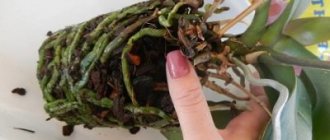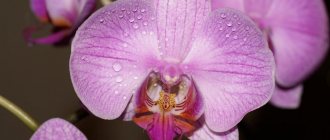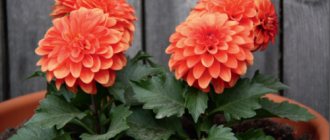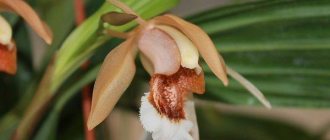You can't do without myths and legends. Especially with the black orchid. And they will tell you numerous stories:
- And about the botanist-naturalist George Cranleith . It was he who, back in the 19th century, decided to pocket a relic of the natives of South America. Unsuccessfully and to the detriment of your life. Although historians cannot remember such a botanist. And the story of the black orchid. Real;
- Tom Ford was impressed and named one of his fragrances “Black Orchid”. He is very popular;
- The girl Black Orchid in the film of the same name directed by Brian De Palma is named so for her special predilection for black clothes.
Existence in nature
- Orchids themselves, like flowering plants, leave few people indifferent. Delight and admiration. And here it is also black. The color of mystery, mystery and uniqueness;
- They talk a lot about them. They show videos and publish photos with love and trepidation. And with noticeable pride of the happy owners of such;
- Are there orchids with black flowers in nature? If they exist, where can I buy them? And how to care for it? The discussions and statements of representatives of opposing opinions are interesting: Those who deny this fact give serious arguments from scientists: There are no purely black genes in nature. This is convincingly proven by scientists. There are no such pigments - says science. So there cannot be exclusively black flowers;
- And the numerous orchids with black flowers available for sale - commercial brand. Take a close look at the flowers. You will see, at best, dark shades of burgundy and blue. There's a lot of money floating around.
- In addition to the stories mentioned, they will tell you many more to confirm the existence of such black flowers;
- Cattleya;
Black cymbidium.
And don’t forget about the art of photography and its possibilities. Lighting and background can change a lot.
History of the selection of “black” orchids
There are a large number of versions of the appearance of this flower on the terenas of Europe. One of them says that during an expedition to the territory of one of the southern tribes, experts stole the tribe’s holy flower - an orchid. For which they paid with their lives. The most valid version is that Californian scientists bred and patented a flower under the name “black orchid”. The plant has an attractive vanilla aroma; it is very elegant and extraordinary. Watch a video about the history of the black orchid:
Reviews
Veronica. “Orchids are a wonderful world of flowers. The more you get to know them, the more you want to know more about them. And if at least one blooms again, I’m ready to buy them again and again. I have heard many times about the capriciousness of cymbidiums (I call them cymbals). I agree with most of them.
But my cymbals turned another page. I received one as a gift.
I organized everything scientifically: the southernmost window. Significant temperature changes (night and day) were ensured by the cool room itself. Watering and fertilizing. Did not work out. The bulbs dried out.
She was a little offended and sent him to the porch for re-education and survival. A year later, another one joined it after flowering. For the whole summer. I only watered on Saturdays. No lighting, moisturizing or spraying. Sometimes she fed me. They began to throw out flower stalks. And bloom.
The cymbal begins to bloom when it becomes a little crowded in the pot. When several good pseudobulbs have formed. Be patient. This applies to all orchids."
Alexandra. “Our forums are filled with the words “oh, I want to buy” or “tell me where?” It's clear. If people start studying, it’s already excitement. They want to sincerely help. I’m more surprised by those who want to buy “this black one, and only...”. First, get to know them, find out if such a thing even exists. And not in one source. And you will learn a lot.
Especially the colors of the flowers. I myself have been convinced more than once that the same thing pleases with different colors. In the morning rays, light colors seem to predominate. With the sun gone and a little twilight, it was as if the burgundy and dark purple ones had turned black. So let black lovers admire orchids with dark colors in this light. But don't deprive them of good lighting. Otherwise you won’t even see flowers. Or you will only see pictures of a flower.
Genetics is a stubborn science. There are no pure black genes in nature. So you need to tell others correctly: “looks like black”, “almost black”. And still others there are the words “it seems to me...”. This will not make dark cherry, burgundy or dark purple colors any worse or less attractive.”
Oksana. “One story happened to me. I ordered a long-awaited and highly advertised orchid. Well, I really wanted it, I liked the way it looked. All the way from overseas. Sent without flowers. The orchid disappeared due to introduced rot. I was very upset. I feel sorry for the flower.
And then I saw it blooming in the photo. And how they made it bloom. They have great respect for their work. I couldn't do that. Only the flowering was not surprising. It was even disappointing.
I recommend it. I wanted to buy some kind of curiosity or exotic thing. Black orchid, for example. Study the conditions for caring for the plant well. It may be a problem for you to grow common violets. Do you want a romantic masterpiece from the Cordillera?
And once you have decided, be prepared to provide proper care. Seeing the flowering pet you grew, you will respect yourself even more. And be sure to share the joy with your friends. A little hint. From dark orchids you can choose ones that are not so picky for our conditions. And they are extraordinarily beautiful.”
Main features of flowering
You have met black orchids. Various types. Each of them is unique. Especially in flowering. Various shapes and sizes of flowers. And other nuances.
Period
- The flowering itself and its periods completely depend on the created conditions . Even within the same species, this can be different. And their duration;
- We strive to please the plants so that they enjoy flowering for longer. And in large quantities;
- And they then reciprocate.
Duration
- Home conditions do not always correspond to natural ones;
- But you can bring them closer;
- Under good conditions (as in their native places): The Dracula Orchid can bloom without interruption . Even a whole year;
- Cymbidium blooms for several months . And for hybrids this happens just in the summer;
- For Paphiopedilum this period may be from October to April ;
- Phalaenopsis pleases with flowers twice a year.
Stimulation
Orchids delight with their flowering when good conditions are created. As close as possible to natural habitat conditions. To speed up their flowering, some techniques are used:
- Reducing watering, for example. Water once a week, if previously watered every 2-3 days;
- They create, as it were, stressful situations. Spring is more suitable. Some gardeners take plants out onto the balcony or into the garden at night. A temperature difference of 4-6 degrees is suitable for this.
Important! All these techniques are performed with adult plants. Their age should be at least 2-3 years.
Main varieties
In nature there is an interesting Takka flower, called the “devil's flower”. Many people mistake it for a variety of black orchids because they are very similar in appearance. Dark shades of petals are also found in different species, for example, paphiopedilum, cattleya, etc. We will dwell in more detail on black orchids from the genus Phalaenopsis. Maxillaria schunkeana is the rarest variety. The plant is low-growing, the flowers are small, and they do not emit aroma. The stem extends at least 30 cm. At home, the plant needs a warm and moderately humid climate. Particular care must be taken when handling the root part. An orchid will not survive in a “swamp” that can form with excessive watering or lack of drainage.
Fredclarkeara After Dark “SVO Black Pearl” is a variety obtained as a result of complex hybridization of different species. An adult plant shoots out 4 arrows at once, on each of which 10 to 15 small flowers grow. Once again, the black flowers resemble the shape of tulips, only they also emit a spicy aroma. The succulent leaf blades are painted bright green. First, the orchid forms leaves, and only then the inflorescences. This usually happens in October-November. At home they adapt without problems. They like it when it is light and warm. It is important not to overwater or overfeed the plant, especially during the period of shedding leaves (before winter).
Paphiopedilum "Pisgah Midnight" of all the varieties of black orchid, its petals have the darkest color. The flowers are monochromatic, the black veins are clearly visible. The shape of the flower is similar to a shoe. Caring for this variety is no different from caring for other orchids. Plant the plant in woody soil in a transparent flowerpot, water and fertilize on time.
Paphiopedilum de Nachtwacht is a dark burgundy beauty that looks like a femme fatale. In the rays of the sun, its petals have a brown tint. On a long peduncle there are two and no larger spectacular flowers in the shape of a shoe. The leaf blades are small, have an elongated shape and look bright and contrasting compared to the dark color of the petals. In order for the flower to develop actively, it is necessary to maintain a comfortable temperature for it (up to +22 °C).
Phalaenopsis Black Butterfly is an amazingly beautiful black orchid from the genus Phalaenopsis. It received such a telling name because of its dark petals, very similar to the wings of a butterfly. The spectacular wine shade gives the flower a special splendor, and the white edging makes it even more sophisticated. If an orchid grows in comfortable conditions, it can decorate itself with small specks on the edges of the petals. This charming, proud “head” flaunts on a long peduncle, decorated with emerald succulent elongated leaf plates. A special charm is given to the whole plant by the deepening of tone and richness of color on the flowers located in the lower tier, and the lighter tones of the upper tier.
Maintenance and care
Let's talk about how to grow an orchid:
- Familiarization with black orchids shows how unique and individual they are: Plant size and flowers;
- Even their blackness is different;
- In growing and caring for each of them, it is imperative to take into account the climate characteristics of its native places ;
- You cannot create an orchid from the Cordillera in the conditions of Southeast Asia.
Try to create natural conditions for the orchid.
- But there are general rules: You need to choose a bright place. Avoid direct sunlight and even drafts;
- Similar soil composition. It should be loose and provide air access. And some people need light.
Important! After purchasing from the store, it is recommended to replant the orchids. This makes it possible to assess the condition of the plant. Plant in native containers. In well-prepared and high-quality soil. If you have purchased a blooming orchid, let it please you with its blooms. Replant when it finishes blooming.
Optimal conditions of detention
Growing conditions determine the growth and flowering capabilities of orchids. We must try to create the climate of their native places :
- You cannot create an orchid from the Cordillera in the conditions of Southeast Asia. Or vice versa;
- But in practice it happens differently. Everything was done according to recommendations and advice. And the plant is harmful. Doesn't want to bloom. Placed in a harsher environment - they bloom and smell;
- And yet we need to start not with experiments. It is better to listen to the advice of experts and experienced amateurs : Temperature;
- Humidity;
- Illumination;
- Containers and soil.
Watering
- During the growing season and increasing leaf mass, the leaves are most abundant;
- The substrate should not dry out: moderately moist will ensure both growth and flowering;
- Dry can cause drying of foliage and peduncles;
- Excessive watering creates a breeding ground for diseases;
- A daily inspection of your pets will allow you to determine the need for watering: In the summer, they are watered more often;
- In winter - less often;
- And during the dormant period, do not water.
The soil of orchids should not be allowed to dry out.
- For most of them, the best method of watering : This is placing the container in a pan of water - up to an hour depending on the size of the pieces of substrate;
- Effective and spillage method;
- Spraying is not for everyone;
- But it's up to you to choose.
Root and foliar feeding
- Phalaenopsis needs to be fed once every two weeks;
- Cymbidium is fed 1-2 times. For the entire growing season. Nitrogen before flowering and dormancy; In winter, fertilizing will not be needed;
- Paphiopedilum once a month. During the flowering period 2 times a month
Seasonal features
- The plants themselves suggest the need for specific actions. As we say seasonally. The growing season begins for most orchids at the end of February The most suitable time for transplanting and dividing bushes;
- During the hot period, direct sunlight should not be allowed. Intensive watering is required;
- In autumn and winter, provide lighting. They respond well;
- Not everyone needs a period of rest. For some it is not so pronounced;
- There is no need to feed during the dormant period;
- The temperature of the content decreases;
- Watering is also reduced.
Advice! Do it only taking into account the type of orchid.
Step-by-step instruction
Potty care
To enjoy the fabulous view of a tropical plant, you need to create comfortable conditions. Black phalaenopsis is a capricious plant, simple soil is not suitable for it. Use loose soil. You can prepare it yourself - add vermiculite, peat soil and pine bark to the soil. 18–22 degrees is the optimal temperature for a tropical flower.
Important! Avoid drafts, dark places, and sunlight.
In summer - abundant watering, in winter - moderate. It is advisable to constantly spray with warm water, especially if the humidity is low. Be sure to settle water for irrigation. If the leaves of the plant are wrinkled, it means there is not enough moisture. If the leaves turn yellow, the flower suffers from excess humidity .
By feeding
Frequent feeding reduces the protective properties of the plant. This is dangerous due to the appearance of pests and various diseases. It is enough to use fertilizing once every two to three weeks - during plant growth. Stores sell special fertilizer for orchids.
By transfer
Once every two years it is necessary to replant the flower in another pot . It is better to replant the plant at the end of winter - during the flower growth period.
Landing
Priming
For all black orchids there are mandatory conditions when choosing soil. It should be loose:
- To ensure air penetration;
- Avoid stagnation of moisture;
- But maintain the necessary humidity.
It may include:
- Small pieces of dry pine bark;
- Charcoal;
- Vermiculite;
- Sphagnum moss;
- Peat;
- Dried fern roots (maybe moss).
Experts advise beginners to purchase soil for orchids in stores. Experienced flower growers prepare it themselves. Taking into account the types and sizes of plants.
Optimal capacity
The size and type of container for planting orchids is selected taking into account the characteristics of the type and size of its roots:
- For phalaenopsis, transparent and small ones are more suitable;
- Large containers are not needed for cymbidium. They do not bloom with empty spaces in pots. When there are several pseudobulbs in a pot, placed closely next to each other;
- Paphiopedilum - wide and shallow. And then the roots will sort themselves out;
- Maxillaria and Dracula are elongated pots. And not necessarily transparent.
Phalaenopsis prefer transparent pots.
Technology
Required steps:
- Prepare a container;
- Prepare the soil;
- Remove the plant from the old container;
- Remove damaged and dried leaves, bulbs, roots;
- Treat the sections with activated carbon and let dry;
- Prepare drainage (expanded clay, shell rock);
- Place the plant in a container and straighten the roots;
- Carefully cover with soil;
- After planting, the plant is not watered. What - 2-3 days. And some - up to 2 weeks;
- Do not allow the rhizome to become buried.
Transfer
- You need to replant as necessary: Purchase;
- The pot is too small;
- Detection of diseases.
Flower planting technology
Planting an orchid is not difficult. However, it is necessary to choose the right pot and soil. How the flower will feel and whether it will be able to develop normally depends on this. It is better to use a plastic pot. It must be transparent. The root system should also receive sunlight. Despite the fact that many phalaenopsis do not need soil, it is better to use it. This will ensure the plant's stability.
There are certain requirements for the selection of soil. It should consist of:
- large bark;
- sphagnum moss;
- coconut fiber;
- coal
Reference. Some florists themselves make the necessary mixture, however, in this case there is a risk that it contains pest eggs. To avoid this, you should buy soil in specialized stores. It has already been treated against possible pests, and is also enriched with nutrients that are so necessary for the plant at any stage of its life. That is, after planting there will be no need to apply mineral fertilizers.
Here's how to plant a flower:
- first you need to disinfect the pot;
- then place a drainage layer in it;
- then you need to pour the prepared mixture into it;
- plant an orchid;
- You also need to sprinkle the flower with a little earth on top.
Important. Do not apply fertilizer right away. The culture needs to be placed in a dark room for a couple of days so that it can acclimatize. Then it is placed in the place where it will grow. From this moment you can begin to introduce fertilizing.
Reproduction methods
Dividing the bush
- It is easy for you to determine the need to plant orchids. The plant has grown a sufficient number of bulbs and is cramped in the pot. So they divide the rhizome into parts. Each one should have 3-4 pseudobulbs. cymbidiums, maxillaria, and paphiopedalums are propagated ;
- Plant in prepared pots;
- And do not water for almost two weeks.
Cuttings
- Experts often practice propagation by cuttings;
- are suitable for this . Which have faded;
- 2-4 dormant buds are left on the cutting;
- Planted in mini-greenhouses. Use sphagnum moss;
- With proper care, root formation and growth are achieved.
Children
- Phalaenopsis produces shoots quite rarely . But there are. They are called children;
- They can be on peduncles and from leaf axils;
- They are helped in the formation of roots;
- Separate from the mother plant with 2-3 good roots formed.
Seeds
- Propagated by seeds;
- Under special conditions. Specialists and breeders;
- You cannot create such conditions at home.
Very important!
- Use sharp and disinfected instruments;
- Make cuts carefully;
- Treat the cuts with activated charcoal or charcoal.
Common diseases, their treatment and prevention
The appearance of diseases is a signal of problems with proper care . In most cases. Particular attention should be paid to watering.
Or they bought it with problems. Carefully inspect the item you choose in the store. And home quarantine for about a month won’t hurt him.
Spider mites, thrips, aphids
- Daily inspections of the condition of orchids are necessary not only to admire the flowers. And also so that none of the pests interfere with them;
- They are small and cannot always be detected immediately. The most common ones to deal with are aphids, thrips and spider mites;
- Soap solutions are used. Alcohol. Even beer;
- Actofit and Fitoverm are used. Only when the initial actions did not produce a positive result.
Fungal infections
Fungal diseases of orchids include:
- Anthracnose;
- Powdery mildew;
- Gray rot;
- Root rot;
- Tracheomycosis.
Root rot.
Prevention and treatment:
- Proper care;
- Application of fungicides. Sulfur is colloidal. Mikosan. Topsin.Fundazol.
Bacterial rot
- Signs of the disease are the appearance of watery light brown spots. They are expanding rapidly;
- Early detection and the opportunity to leave at least something unaffected will allow you to cure;
- And preventive treatments with copper preparations.
Gray rot
- Mold, fluffy islands and gray mold may appear after spraying plants at low temperatures;
- Remove affected parts;
- Treat with fungicides.
Anthracnose
- The appearance of small depressed brown spots with a yellow rim on leaves and bulbs . And a yellowish or pinkish coating;
- Remove affected areas. Maybe whole leaves;
- Reduce watering. Treat with copper preparations. At least twice a month.
Advice! You can use ash and even brilliant green.
Leaf spot
- Orchid leaves are an indicator of a healthy plant;
- Stain spots can form after excessive watering. This can be easily remedied by wiping the leaves;
- But there are more serious ones. Numerous moist dark spots;
- Remove affected leaves;
- Stop watering. For now for a week;
- Treat with fungicides. Fitosporin. Topsin. Fundazol.
Leaf spotting.
What to do if the black orchid does not bloom?
Many people talk about the capriciousness of orchids. And blacks, too. After acquisition, they get used to your conditions for quite a long time. Adaptation depends on the conditions of care:
- Pay attention to age. 1.5-2 years are still young. If everything has been provided, be patient;
- Analyze your conditions: Maybe the lighting is not all right? And you need good lighting;
- The difference between night and day temperatures within 5-7 degrees is very important;
- Are watering and fertilizing correct and timely?
- Have you found a suitable pot with soil?
- Or are there other miscalculations?
The popularity of the “black” orchid
Dark colors are considered to be mournful and sad, but at the same time they hide a mystery and are surrounded by an aura of mystery and grace. The black orchid is perceived by many as a noble and very expensive flower, so it is not surprising that its name is used to name flower salons.
Latest articles about gardening
Alstroemeria photo of flowers Aloe: growing at home Anemones: planting and care in the open ground, photo
Director Brian de Palma decided to call his film this way, in which the main character received the nickname Black Orchid for her love of everything black and extraordinary beauty. Tom Ford named this one of his best fragrances. The black orchid is constantly in the news, and although it does not exist in nature, many people sincerely believe that it exists, just like the black tulip. Perhaps in the near future, breeders will be able to accomplish the impossible and create a completely black flower.
Nuances and questions from readers
What is the price?
How much does a flower cost? Many people have this question on their lips. The cost of orchids depends on the types, varieties, and sizes of plants. And from flowering at the time of sale. Many people need a blooming orchid as a gift.
Important! Their condition is usually indicated in price lists:
- S/S seedling;
- NB/S – young plant. Has not yet reached the age for flowering;
- B/S – has not bloomed yet. But it's already ready;
- F/S – adult. It was already blooming.
An online orchid store in Kyiv offers a specimen of Dracula roeslii that has not had time to bloom. But ready to bloom B/S. For 3240 UAH. Its relatives are much cheaper - 2-3 times.
This is Dracula vampira:
- In Moscow for 9800 Rubles. F|S;
- And in Kiev 2730 UAH. Compare for yourself at the rate.
But phalaenopsis can be bought even for 1000 rubles in Moscow.
Why do you dream?
You dreamed of a black orchid. It's very possible. If that's all you think about:
- Here's according to Miller's dream book . A blooming orchid predicts success in a risky business. Even completely hopeless ones. And he will also promise pleasure. Sensual, refined and sophisticated. Happiness in your personal life and success in love;
- According to Freud. This is a prediction of changes in sexual life and a possible meeting of your other half.
After such predictions, I don’t want to look any more.
Photos of orchids
Orchids look especially impressive in black and white pictures.
Black and white orchids (photo of phalaenopsis).
This picture shows orchids on a black background.
Photo of a white orchid on a black background.











